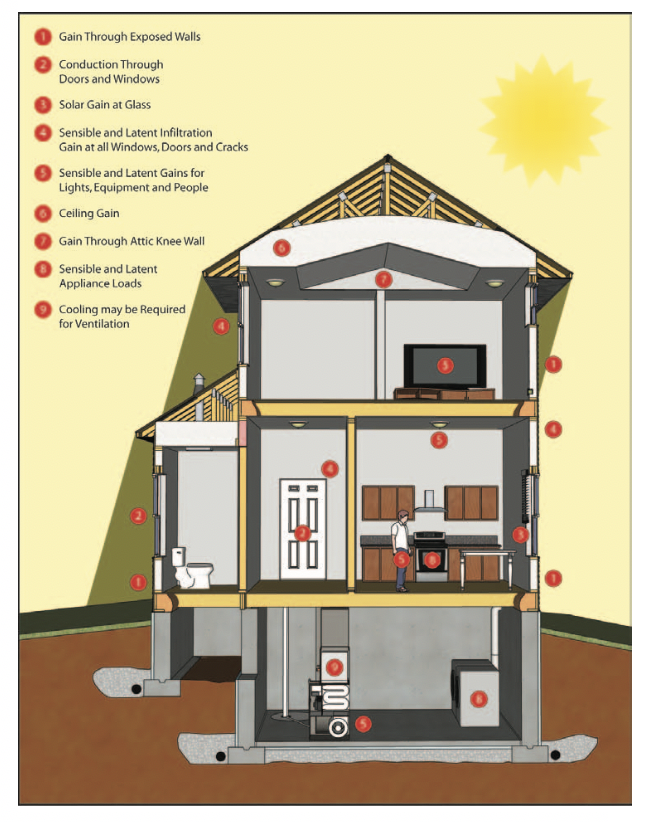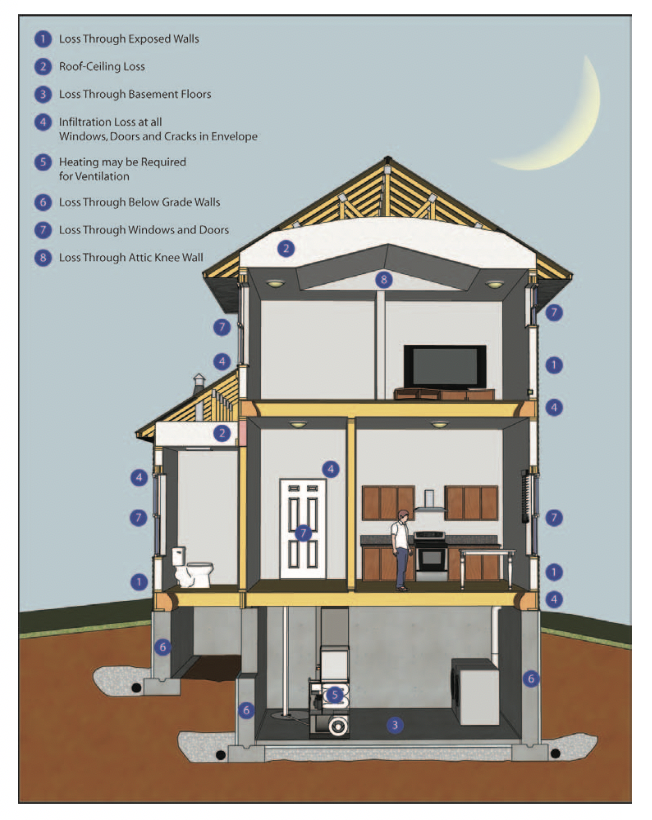Part-Load Efficiency
New ResidentialWhat is Part-Load Efficiency?
Part-load efficiency refers to the ability of an HVAC system to handle part-load energy use. Factors that impact the internal load of a home include heat generated by occupants, processes, equipment, and lighting (see Figure 1); External load variables include insulation levels, glazing and window selection, and building orientation (see Figure 2).[1] HVAC systems are designed to serve a wide range of loads. Higher efficiency standards set by ASHRAE 90.1 and advances in HVAC technology make modern systems highly efficient at full or maximum loads. However, efficiency rates decline at part-load or when loads fall below 90%, making it challenging for residences that experience variable loads throughout the day to maximize energy savings.[2] Coupled with the fact that most design engineers oversize HVAC systems, selecting equipment and technologies designed for part-load operation offer the potential for significant energy savings (see Properly Sized HVAC Equipment).[3]

Figure 1. Heat Gain Locations (Source: NREL)
How to Implement Part-Load Efficiency
First, consider all aspects of the home as part of an integrated design process and incorporate energy-efficient strategies that reduce heating and cooling loads. Install smart thermostats and HVAC systems that use multiple sensors and controls to monitor and ensure proper humidity levels and temperature settings, control energy consumption in unoccupied areas, and detect and diagnose issues (see Smart Sensors and Controls). Use energy modeling to understand the impacts of different energy-efficient design measures and operations on peak heating and cooling loads and overall system loads as well as the expected average runtime of the HVAC system under part- load conditions (see Energy Modeling).
For residences with significant part-load profiles, select equipment and components that can operate efficiently at part-load or that can modify capacity at varying loads such as variable speed compressors, fans, and pumps; and temperature reset controls for hot water and supply air.[4] For example, variable speed compressors use an inverter known as a variable frequency drive (VFD) to run a motor at different speeds to match the load and help reduce energy consumption. To reduce central air conditioning loads and provide zoning or heating and cooling for individual spaces, consider modular, mini split-system air-conditioners.[5]

Figure 2. Heat Loss Locations (Source: NREL)
Benefits
Designing for part-load efficiency optimizes energy-efficiency and cost-effectively reduces energy use, water consumption, and emissions, and manages occupant comfort and indoor air quality.
Costs
The cost of implementing part-load efficiency varies depending on the equipment and system selected. Considering part-load performance when designing and installing a system saves on first costs as well as operating costs.[6]
Check the New Jersey Office of Clean Energy for available equipment incentives.
Resiliency
Part-load efficiency increases resiliency by decreasing energy and water consumption, including peak loads, which decreases reliance and stress on the electricity grid, natural gas, and water and wastewater infrastructure.
[1] Burdick, Alan. 2012. “Strategy Guideline: HVAC Equipment Sizing” Prepared for the US DOE Building America Building Technologies Program. https://www.nrel.gov/docs/fy12osti/52991.pdf (accessed November 27, 2018).
[2] Whole Building Design Guide. 2016. High-Performance HVAC. National Institute of Building Science. https://www.wbdg.org/resources/high-performance-hvac (accessed Nov 28, 2018).
[3] Whole Building Design Guide. 2016. High-Performance HVAC. National Institute of Building Science. https://www.wbdg.org/resources/high-performance-hvac (accessed Nov 28, 2018).
[4] Whole Building Design Guide. 2016. High-Performance HVAC. http://www.wbdg.org/resources/hvac.php (accessed June 5, 2018).
[5] US DOE- Energy Savers. “Ductless, Mini-Split Air Conditioners.”
https://www.energy.gov/energysaver/ductless-mini-split-air-conditioners (accessed Nov 29 2018).
[6] Whole Building Design Guide. http://www.wbdg.org/resources/hvac.php (accessed March 20, 2011).
